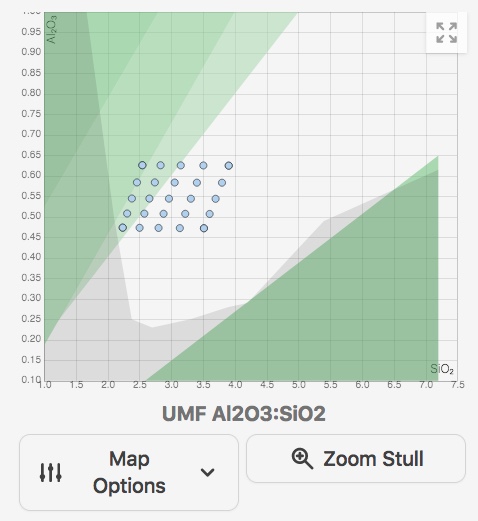This is the Stull Map. The vertical axis on this grid measures alumina. The horizontal axis on this grid measures silica. That white section in the middle labeled bright is where all of the durable glossy glazes are located. If you enter a glaze recipe into the website
glazy.org it will automatically plot your recipe on a Stull Map.

There was a discussion on the Clayart Listserv group about the Rhodes 32 glaze. This is where Rhodes 32 lands on the Stull Map - it lands in the semi-matte region. Rhodes 32 has a problem with cutlery marking and the discussion revolved around how to correct that.
I used the glaze calculation feature on Glazy.org to map out four corners for a biaxial grid. The bottom left glaze is the original Rhodes 32 recipe. The top left glaze has added alumina. The top right has added alumina and silica when compared to the original. The bottom right glaze has added silica.
I used the biaxial blend option in Glazy to generate a 5x5 grid. If I were looking to explore this glaze I could mix up the four corner glaze recipes and then use Ian Currie's volumetric blending method to create the 25 glazes in this grid.
This is an example of how I use the biaxial grid method on the website glazy. Each glaze in this set of 25 glazes has the same fluxes in a .3 to .7 R2O to RO ratio. What varies is the amount of alumina and silica in each of them.
This type of grid can help you spot trends. The glazes on the left are matte. As silica is added they move into the glossy range. You can see that some of the matte glazes on the left are runny. That is what happens when a matte glaze is over-fired - it runs. But if you add silica to that same matte glaze, it turns glossy and you can see that happening in this grid.

This is the Stull Map for the biaxial grid set of mine. If you study this image, you will see that many of the glazes are in the matte and semi-matte region on the Stull Map. This corresponds well with my fired results. Notice that the glossy glazes that I generated with that grid set are plotted in the glossy area of this Stull Map.
I think of the Stull Map as a compass. It can help you spot the trends that happen in a glaze when you vary the amounts of alumina and silica in that glaze. The line between semi-matte and glossy is not a hard and fast rule where moving one small bit over that line from the semi-matte to the glossy region generates a glossy glaze. Rather what happens is that if you create a biaxial grid of your glaze, you can use it to spot the trends and then zero in on the results you wish to explore. Looking at the fired results of this grid has led me to make up a batch of glaze A2 because it is a lovely blue-green matte with crystals.





